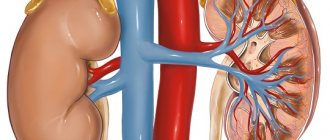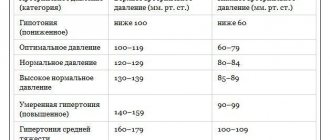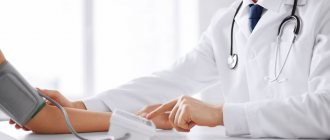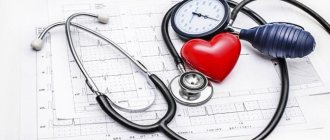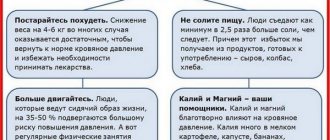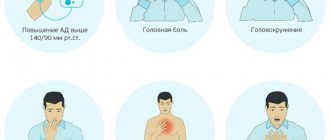The blood pressure level shows the general condition of the patient’s body and the degree of functional activity of the cardiovascular system. A decrease in diastolic blood pressure is called isolated hypotension.
In contrast to the classical type of pathology, there is a pronounced asymmetry between the two levels. Moreover, the difference can reach up to 60 mmHg and even higher, which indicates the pathological nature of the pathology.
The result of subtracting the systolic and diastolic levels is called pulse pressure, and it is this that needs to be checked in this case.
Diagnosis is usually made based on stress tests. Isolated diastolic hypotension persists at any level of blood pressure, even against a background of 180 mmHg after physical activity, the pulse pressure will be 60 or even more, which facilitates early diagnosis and allows you to quickly determine the type of process.
A pressure of 120 over 60 means that the patient suffers from cardiovascular, nephrological, endocrine or neurological diseases. A whole group of specialists will have to figure it out.
Is 120/60 normal?
No, this level of blood pressure is not considered normal. According to the established values (World Health Organization), the reference indicator is from 110 to 130 by 80-85. Deviations within the minimum limits are possible (10 mmHg or slightly less).
When calculating the norm, individual performance indicators are taken into account. However, the WHO recommendations do not say anything about significant pulse pressure.
Independent research and protocols of national heart associations put an end to the issue. According to them, the pressure is 120 to 60 mmHg. Art. is not the norm, since the difference between systolic and diastolic indicators is exceeded by more than 30-40 units. Accordingly, you need to look for the cause and prescribe treatment.
Independent measures to raise one blood pressure level are impossible: not all drugs have selectivity, and you won’t be able to choose the right combination on your own. But it’s quite possible to make it worse, and no one can predict in advance how it will end. In all situations, it is recommended to consult a cardiologist for help.
What will help normalize blood pressure levels?
If no serious pathologies are detected with a blood pressure of 120/60 in an adult (elderly) person, the doctor will give recommendations for lifestyle correction. The rise in diastolic blood pressure is promoted by:
- daily physical activity, long walks in fresh air;
- long night sleep up to 8 hours;
- going to bed before 11 pm daily;
- set time for getting up in the morning;
- morning work-out;
- sports (swimming, cycling).
Good results can also be achieved by correcting the diet. The following products are considered mandatory for hypotension:
- nuts rich in vitamins B, E (hazelnuts, cashews, walnuts, sunflower seeds);
- wholemeal bread with bran;
- leafy greens (spinach, lettuce);
- fresh fruits, vegetables;
- lean meat, sea fish;
- good butter, as well as vegetable oils (olive, sunflower);
- spicy spices.
You need to eat in fractional portions. The number of meals is at least four, at equal intervals (three hours). Small doses of good dry red wine will also be beneficial.
Reasons for a persistently low diastolic reading
The factors for the development of isolated hypotension are diverse. Among the most common are a number of physiological and pathological ones.
Natural. Caused by non-pathogenic changes in the body
- Temporary hormonal imbalances. They develop as a result of several reasons. Puberty. Puberty. Associated with surges in estrogen or androgens. The period falls on the age from 12 to 18-19 years. All this time, the teenager’s blood pressure is in an unstable state, either increasing or decreasing throughout the day. Menstrual cycle, pregnancy. It is difficult for representatives of the fairer sex to tolerate precisely because of vegetative manifestations. A blood pressure of 120 over 60 during pregnancy may be normal. But in any case, diagnosis is necessary. Climax. Both men and women. It is accompanied by a total hormonal imbalance, which can only be corrected by medication.
- Sex and age characteristics. Young girls have a smaller heart size, so their blood pressure is, on average, higher than that of men. This is observed throughout life. The individual norm regarding pulse pressure, however, cannot be more than 40 mmHg for a long period. This is an indication of a pathological process. What kind - you have to find out with your doctor.
- Overwork. This affects the release of stress hormones and the production of toxins that are dangerous to the nervous system. A proper rest is necessary if your own working pressure has not been restored at the end of sleep.
- Heavy physical overload, emotional component. The factor in the development of the problem is the same. You need to come to your senses and take a few tablets of a sedative of plant origin (valerian, motherwort).
- Meteosensitivity. From 20% to 40% of the population suffers from a pronounced reaction to changing weather. This is due to the instability of the nervous system, which cannot regulate the state of the body and adequately increase or decrease blood pressure levels in response to changes in the barometer. This can be solved by taking medications that improve brain nutrition and blood circulation.
These factors are taken into account first. Only then do they look for pathological causes. The latter are more common. Natural ones can be dismissed in the process of initial diagnosis.
Pathological. Associated with the course of a particular disease
The list of such is wide:
- Hypothyroidism. A decrease in the concentration of thyroid hormones as a result of insufficiently active functioning of the organ. Tumors, other neoplasias, injuries and poor nutrition have an effect. A whole complex of symptoms of various kinds arises, which are difficult not to pay attention to. On the other hand, this is at least a small plus. The patient has time to react. The manifestations force one to go to the doctor, since the standard of living is significantly reduced.
- Diabetes. A systemic endocrine disease that destroys the entire body to its core. Both the nervous and circulatory systems suffer. In addition, the excretory tract, connective tissue, bones, etc. It is treated for life. The pressure in such a situation is corrected by constant intake of tonic drugs.
- Pathologies of the adrenal glands based on the type of deficiency of cortisol synthesis. Induced Addison's disease. Occurs with injuries, tumors, and operations on the anatomical site. Requires replacement treatment under the supervision of an endocrinologist. Without the use of medications, blood pressure can drop to critical levels in a short time.
- Pituitary pathologies. Associated with insufficient secretion of corticotropin. The factors causing the problem are different: neoplasia, mechanical damage, etc.
- Osteochondrosis of the cervical spine and other systemic diseases of the musculoskeletal system and muscle fibers. They cause compression of arteries located in the anatomical area. They provoke a violation of the trophism of brain structures that regulate the normal tone of vascular formations. The body begins to give chaotic signals, provoking jumps in the level of the tonometer, so 120/60 is still a mild option. The process is not always symmetrical; it all depends on the individual characteristics of the patient’s body.
- Anemia. Develops as a result of bleeding, poor nutrition, and genetic abnormalities. Accompanied by a decrease in hemoglobin concentration and, accordingly, a change in the properties of liquid connective tissue and organ hypoxia. The heart has to work harder to pump blood as it becomes thicker. An important element is the presence of additional, unusual symptoms: brittle nails, hair, cracking and dry skin, problems with teeth, vision, addiction to inedible things.
- Problems with the excretory system. There are a lot of disease options. Ultrasound diagnostics is needed to put an end to the issue. Arterial hypotension with a pressure level of 120 to 60 is the result of a decrease in renin production and disturbances in general hemodynamics (fluid comes out too actively, dehydration is possible).
- Pathologies of the central nervous system. Dyscirculatory changes lead to generalized problems with blood pressure.
Constant smoking, alcohol abuse and other factors of a similar subjective nature also have an effect. It is necessary to understand in more detail.
Treatment of hypotension
Sometimes, lifestyle and dietary adjustments to raise blood pressure may not be enough. Then, the attending physician prescribes therapeutic treatment, recommending certain medications.
As a rule, herbal medicines are prescribed first. They have a delicate effect on the cardiovascular and nervous systems. Have a mild stimulating effect. Especially often, patients are recommended to take certain doses of the following alcohol tinctures:
- Eleutherococcus;
- aralia;
- lemongrass;
- ginseng.
If the therapeutic effect is insufficient, synthetic drugs can be added: anticholinergics, adrenergic agonists, nootropics, analeptics.
Only a doctor should recommend certain medications, set their dosage, and duration of use. Self-medication is unacceptable.
Excellent results are achieved using physiotherapeutic methods. This can be a massage, electrotherapy (Darsonval, electrosleep), baths with the addition of essential oils, Charcot's shower.
What role does high or low heart rate play?
Heart rate is not very important in identifying the causes of low blood pressure. The heart rate is determined by the stimulation of a special reflex zone of the organ itself.
The indicator is also explained by the work of the brain stem and hypothalamus (to its fullest extent). Often, blood pressure and pulse are not related to each other in any way, and are caused by one reason. It's just a coincidence. However, the pulse rate plays a role as a symptom that needs to be relieved.
Will I be able to increase the lower level on my own?
It's almost impossible to do this. When taking hypertensive drugs, both indicators increase: systolic and diastolic. In order to selectively influence the desired value, a combination of several drugs will be required; it can only be selected through testing, as part of inpatient examination and treatment. It is impossible to do this on your own; you need to consult a doctor. And this will be the best solution to the problem.
To urgently help your own body, you need to take a horizontal position, free your neck from oppressive clothing, then you should call an ambulance, especially if your blood pressure readings are at critical levels and wait for the doctors to arrive.
You cannot take baths, wet your hands, wash your face, or eat food. Loss of consciousness, vomiting, asphyxia and death are possible.
It is advisable to have someone familiar nearby to assist with syncope.
Nothing more can be done at home; all other measures should be entrusted to medical personnel.
WHAT IS THE DANGEROUS OF HIGH BLOOD PRESSURE IN A CHILD?
Every third child with this disease may develop hypertension in the future. High blood pressure affects both the general condition of the child - fatigue, retarded mental and physical development - and various organs, such as the eyes, kidneys, and heart.
But, I would like to emphasize that in children prevention and treatment are more effective than in adults and a complete cure is possible!
Pediatrician and pediatric cardiologist Ekaterina Aleksandrovna Yakunina.
When is it necessary to contact a specialist?
You should visit your doctor if you have at least one of the following manifestations:
- Blood pressure is 120 over 60 and I have a headache. Consequence of disturbances of local and general hemodynamics (muscular, cerebral, renal). Vegetative symptoms affect.
- Vertigo. Dizziness for a long period of time with alternating improvements and worsening. In extreme cases, complete disorientation in space occurs. The cerebellum and inner ear are affected.
- Arrhythmia type tachycardia or reverse process, when the heart rate drops. Moreover, the help of a doctor is required if the heart beats without a pronounced rhythm, convulsively.
- Chest pain of a pressing nature without signs of contractile dysfunction.
- Fainting. Syncope. Loss of consciousness. Hypotension occurs repeatedly throughout the day. The higher the pulse pressure, the more significant the manifestation.
- Shortness of breath not associated with physical activity. Choking, problems with lung function.
- Cognitive impairment, severe brain manifestations.
- Problems with libido, menstrual cycle.
- Visual changes, tinnitus.
Correcting manifestations is not yet a cure, but it is already an important step. There is no need to delay visiting a specialist if you have at least one symptom.
Prevention methods
Low blood pressure can be either congenital or acquired. In young people, hypotension is often caused by stress, poor diet, and vitamin deficiency (especially A, C and E). In order to maintain the health of the cardiovascular system and prevent most dangerous diseases, it is enough to follow a few simple advice from doctors:
- spend less time in stuffy rooms - this leads to oxygen starvation of cells and tissues;
- ensure proper rest - daily sleep of at least 7-8 hours is important for restoring the body after a working day;
- regularly engage in sports at an amateur level - the muscular layer of the vascular walls and myocardium also need constant training;
- eat well, get enough vitamins;
- Every morning, do a little exercise to improve blood circulation before getting up - this will help prepare the cardiovascular system for the start of the day and avoid sudden stress.
Often a headache with low blood pressure is a dangerous symptom. Doctors at the Clinical Institute of the Brain recommend not to self-medicate, since hypotension is often chronic and can progress. It is important to undergo an examination in time and select medications that will strengthen blood vessels, improve blood circulation, relieve headaches and prevent the dangerous consequences of the disease.
Necessary examinations
The list of diagnostic measures is determined based on the suspected disease.
To draw primary conclusions, you will need to collect a list of the patient’s complaints and life history, also take into account family history, everyday life and a number of other factors.
All this falls on the shoulders of the cardiologist. If necessary, other specialists may be involved: endocrinologist, neurologist and nephrologist.
To verify the diagnosis, you will need the following methods:
- Assessment of blood pressure level, calculation of pulse blood pressure.
- Measuring the tonometer indicator within 24 hours using a special automatic monitor.
- Electrocardiography with stress tests. With such a high pulse pressure, it is carried out with great caution and a first aid team is on duty.
- Fainting is possible right during the diagnostic process.
- Echocardiography.
- Measuring brain activity.
- Blood tests for hormones and biochemical levels.
If necessary, angiography and other diagnostic techniques are prescribed. But in most cases, the ones listed are sufficient.
HOW TO CORRECTLY MEASURE A CHILD'S BP?
1. First, understand what pressure will be normal for your child. To do this, you need to use three percentile tables (tables of percentages of different values):
- In Table 1, find your child’s age and height (for boys and girls, these are different parts of the table) and remember your child’s “height percentile” (from 5% to 95%).
- In Table 2 (for boys) or in Table 3 (for girls) look for the child’s age, correlate it with the “height percentile” and then find the value for the upper (systolic) and lower (diastolic) pressure. The optimal value will be up to 90%. Above is already above the norm.
2. In order to measure blood pressure, you need a tonometer, but most importantly, the correct - children's - cuff. For electronic tonometers there is only one children's cuff (diameter 15-22 cm). For mechanical ones, the diameter of the cuff for children starts from 7 cm. The size of the cuff corresponds to the circumference of the arm at the place where it is applied (measured with a measuring tape).
3. Measure blood pressure in your arms three times with an interval of 2-3 minutes, and calculate the average value. Compare with recommended.
4. Keep a blood pressure diary. If there was a one-time increase, it is recommended to measure 2-3 times during the day at rest while sitting, as well as in case of characteristic complaints (headaches, nosebleeds, dizziness).
Treatment tactics
Dual. It consists of eliminating symptoms and improving the quality of life on the one hand, and on the other hand, fighting the root cause, and this is the most important point.
The list of methods varies from prescribing tonic medications to surgical interventions and the use of hormone replacement therapy. Lower blood pressure can be increased using selective methods, by selecting the right combination of corticosteroid-based drugs and classical tonic drugs.
An important role is played by the normalization of sleep and wakefulness, diet, and the use of vitamin and mineral complexes. Quitting smoking and drinking alcohol will have a positive effect (there is nothing useful in alcohol).
Treatment lasts from several months to a year, followed by a period of maintenance therapy. As a rule, hypotension does not recede on its own and is kept within limits only thanks to medications.
A blood pressure of 120 over 60 is a pathological level. Systemic correction is required under the control of a whole council of specialists.

